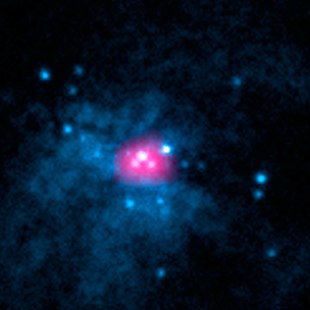M82 X-2
| Pulsar M82 X-2 | |||||
|---|---|---|---|---|---|
 | |||||
| M82 X-2 (rot) und M82 X-1 (blau) aufgenommen mit NuSTAR | |||||
| AladinLite | |||||
| Beobachtungsdaten Äquinoktium: J2000.0, Epoche: J2000.0 | |||||
| Sternbild | Großer Bär | ||||
| Rektaszension | 09h 55m 51,04s [1] | ||||
| Deklination | +69° 40′ 45,5″ [1] | ||||
| Astrometrie | |||||
| Entfernung [2] | 12 Mio. Lj 3,6 Mio. pc | ||||
| Physikalische Eigenschaften | |||||
| Rotationsperiode | 1,37 s [2] | ||||
| Andere Bezeichnungen und Katalogeinträge | |||||
| |||||
| AladinLite | |||||
M82 X-2 ist die zweite Ultraleuchtkräftige Röntgenquelle (ULX) in der Galaxie Messier 82 neben M82 X-1. Das besondere an M82 X-2 ist, dass es sich bei dem Objekt offenbar um einen Röntgenpulsar handelt und nicht um ein Schwarzes Loch[2][3]. Auf die Natur als Pulsar lässt sich aufgrund des gepulsten Röntgensignals schließen.
Vor der Entdeckung von M82-X2 war vermutet worden, dass alle ULX akkretierende Schwarze Löcher sind. Das Objekt ist somit Stand 2014 der hellste bekannte akkretierende Pulsar überhaupt. Die Entdeckung hat die Frage aufgeworfen, ob Neutronensterne möglicherweise eine häufige Quelle des ULX-Phänomens sind.
Beobachtung
Das Objekt wurde mit dem NuSTAR-Teleskop im Jahre 2014 untersucht im Rahmen einer Beobachtung der Supernova SN 2014J sowie mit dem Chandra-Satelliten und Swift-Satelliten.
Eigenschaften
Der Pulsar hat eine mittlere Periode von 1,37s und eine zweite sinusförmige Modulation über 2,5 Tage. Er strahlt eine Energie von 4,9×1039 Erg pro Sekunde ab, wobei das Maximum bei 1,8×1040 Erg pro Sekunde liegt. Damit liegt die Energieabstrahlung etwa beim 10 millionenfachen der Sonne, obwohl der Pulsar wohl nur wenig mehr Masse hat als die Sonne. Der Pulsar ist damit auch heller als normalerweise über die Eddington-Grenze erlaubt. Eine mögliche Erklärung könnten geometrische Effekte sein.[4] Gegenstand der Untersuchungen ist momentan auch die Stärke des Magnetfelds. Eine Studie aus dem Jahr 2017 kommt zum Schluss, dass das Magnetfeld bei weniger als 1013 G (109T) liegt, womit es sich bei dem Objekt wohl nicht um einen Magnetar handelt,[5] jedoch konnte diese Fragestellung auch noch nicht eindeutig geklärt werden.[3] Die Helligkeit entsteht wohl durch einen extremen Materiestrom vom Begleiter zum Pulsar. Pro Jahr scheint etwa die 1,5-fache Masse der Erde vom Begleiter auf den Pulsar transferiert zu werden.[3][6]
Begleiter
Über den Begleiter des Pulsars ist bisher wenig bekannt. Er muss allerdings ziemlich massereich sein, um die Helligkeit des Pulsars erklären zu können. Schätzungen gehen von mindestens 5 M☉ aus bei Annahme von 1.4 M☉ des Pulsars.[2], möglicherweise könnten es auch 100 M☉ sein.[3] Beide Massen konnten aber bisher nicht eindeutig bestimmt werden.
Weblinks
- Anne M. Stark: Dead star shines on. 9. Oktober 2014 (englisch).
- M82 X-2 Star Facts (Colour & more). (englisch).
Einzelnachweise
- ↑ M82 X-2. In: SIMBAD. Centre de Données astronomiques de Strasbourg, abgerufen am 6. Juli 2023.
- ↑ a b c d M. Bachetti, F. A. Harrison, D. J. Walton, B. W. Grefenstette, D. Chakrabarty, F. Fürst, D. Barret, A. Beloborodov, S. E. Boggs, F. E. Christensen, W. W. Craig, A. C. Fabian, C. J. Hailey, A. Hornschemeier, V. Kaspi, S. R. Kulkarni, T. Maccarone, J. M. Miller, V. Rana, D. Stern, S. P. Tendulkar, J. Tomsick, N. A. Webb, W. W. Zhang: An ultraluminous X-ray source powered by an accreting neutron star. In: Nature. 514. Jahrgang, 9. Oktober 2014, S. 202–204, doi:10.1038/nature13791, PMID 25297433, arxiv:1410.3590, bibcode:2014Natur.514..202B.
- ↑ a b c d Matteo Bachetti, Marianne Heida, Thomas Maccarone, Daniela Huppenkothen, Gian Luca Israel, Didier Barret, Murray Brightman, McKinley Brumback, Hannah P. Earnshaw, Karl Forster, Felix Fürst, Brian W. Grefenstette, Fiona A. Harrison, Amruta D. Jaodand, Kristin K. Madsen: Orbital Decay in M82 X-2. In: The Astrophysical Journal. 937. Jahrgang, Nr. 2, 5. Oktober 2022, ISSN 0004-637X, S. 125, doi:10.3847/1538-4357/ac8d67, arxiv:2112.00339, bibcode:2022ApJ...937..125B.
- ↑ Suspected Black Hole Unmasked as Ultraluminous Pulsar. NASA, abgerufen am 13. Juli 2018.
- ↑ Kun Xu, Xiang-Dong Li: On the Magnetic Field of the Ultraluminous X-Ray Pulsar M82 X-2. In: The Astrophysical Journal. 838. Jahrgang, Nr. 2, 1. April 2017, S. 98(6pp), doi:10.3847/1538-4357/aa65d5, arxiv:1704.00171, bibcode:2017ApJ...838...98X.
- ↑ NASA Study Helps Explain Limit-Breaking Ultra-Luminous X-Ray Sources. JPL, 6. April 2023, abgerufen am 6. Juli 2023 (englisch).
Auf dieser Seite verwendete Medien
Autor/Urheber: IAU and Sky & Telescope magazine (Roger Sinnott & Rick Fienberg), Lizenz: CC BY 3.0
IAU Ursa Major chart, also known as the Great Bear.
This image shows the core of galaxy Messier 82 (M82), where two ultraluminous X-ray sources, or ULXs, reside (X-1 and X-2). ULXs are regions that shine intensely with X-rays. Astronomers previously believed that all ULXs were the result of actively feeding black holes; as the black holes pull matter onto them from companion stars, the matter heats up and blazes with X-rays. X-2 is the largest point of light in the pink field, while X-1 is the large point to the right of X-2 (see annotations on the image).
NuSTAR has added a new twist to the mystery of ULXs by showing that one of the ULXs in M82, called M82 X-2, is not a black hole but a pulsar. The observatory's high-energy X-ray observations caught a telltale pulse of X-rays coming from the object. A pulsar is a leftover core of an exploded star that sends out rotating beams of high-energy radiation. Pulsars are not as massive as black holes, so researchers are confounded by the immense amount of radiation pouring out of this relatively puny, compact object.
Meanwhile, other researchers, using data from NASA's Rossi X-ray Timing Explorer, recently found evidence that the other ULX in M82, called M82 X-1, is indeed a black hole. They think it might belong to a long-sought intermediate-mass class -- a missing link between smaller, stellar-mass black holes and the gargantuan ones that dominate the centers of most galaxies. Together, these results suggest that ULXs may be more diverse than once believed.
The image is a combination of high-energy X-ray data taken by NuSTAR (pink) and lower-energy X-rays captured by NASA's Chandra X-ray Observatory (blue).Opaque red circle



